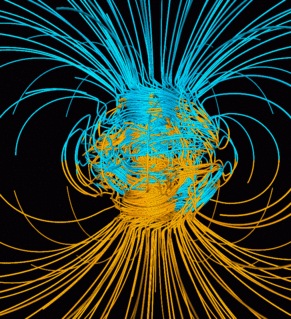 W
WEarth's magnetic field, also known as the geomagnetic field, is the magnetic field that extends from the Earth's interior out into space, where it interacts with the solar wind, a stream of charged particles emanating from the Sun. The magnetic field is generated by electric currents due to the motion of convection currents of a mixture of molten iron and nickel in the Earth's outer core: these convection currents are caused by heat escaping from the core, a natural process called a geodynamo. The magnitude of the Earth's magnetic field at its surface ranges from 25 to 65 μT. As an approximation, it is represented by a field of a magnetic dipole currently tilted at an angle of about 11 degrees with respect to Earth's rotational axis, as if there were an enormous bar magnet placed at that angle through the center of the Earth. The North geomagnetic pole actually represents the South pole of the Earth's magnetic field, and conversely the South geomagnetic pole corresponds to the north pole of Earth's magnetic field. As of 2015, the North geomagnetic pole was located on Ellesmere Island, Nunavut, Canada.
 W
WGanymede, a satellite of Jupiter, is the largest and most massive of the Solar System's moons. The ninth-largest object in the Solar System, it is the largest without a substantial atmosphere. It has a diameter of 5,268 km (3,273 mi), making it 26% larger than the planet Mercury by volume, although it is only 45% as massive. Possessing a metallic core, it has the lowest moment of inertia factor of any solid body in the Solar System and is the only moon known to have a magnetic field. Outward from Jupiter, it is the seventh satellite and the third of the Galilean moons, the first group of objects discovered orbiting another planet. Ganymede orbits Jupiter in roughly seven days and is in a 1:2:4 orbital resonance with the moons Europa and Io, respectively.
 W
WThe magnetosphere of Jupiter is the cavity created in the solar wind by the planet's magnetic field. Extending up to seven million kilometers in the Sun's direction and almost to the orbit of Saturn in the opposite direction, Jupiter's magnetosphere is the largest and most powerful of any planetary magnetosphere in the Solar System, and by volume the largest known continuous structure in the Solar System after the heliosphere. Wider and flatter than the Earth's magnetosphere, Jupiter's is stronger by an order of magnitude, while its magnetic moment is roughly 18,000 times larger. The existence of Jupiter's magnetic field was first inferred from observations of radio emissions at the end of the 1950s and was directly observed by the Pioneer 10 spacecraft in 1973.
 W
WMercury's magnetic field is approximately a magnetic dipole apparently global, on planet Mercury. Data from Mariner 10 led to its discovery in 1974; the spacecraft measured the field's strength as 1.1% that of Earth's magnetic field. The origin of the magnetic field can be explained by dynamo theory. The magnetic field is strong enough near the bow shock to slow the solar wind, which induces a magnetosphere.
 W
WNeptune is the eighth and farthest-known Solar planet from the Sun. In the Solar System, it is the fourth-largest planet by diameter, the third-most-massive planet, and the densest giant planet. It is 17 times the mass of Earth, slightly more massive than its near-twin Uranus. Neptune is denser and physically smaller than Uranus because its greater mass causes more gravitational compression of its atmosphere. The planet orbits the Sun once every 164.8 years at an average distance of 30.1 AU. It is named after the Roman god of the sea and has the astronomical symbol ♆, a stylised version of the god Neptune's trident.
 W
WThe magnetosphere of Saturn is the cavity created in the flow of the solar wind by the planet's internally generated magnetic field. Discovered in 1979 by the Pioneer 11 spacecraft, Saturn's magnetosphere is the second largest of any planet in the Solar System after Jupiter. The magnetopause, the boundary between Saturn's magnetosphere and the solar wind, is located at a distance of about 20 Saturn radii from the planet's center, while its magnetotail stretches hundreds of Saturn radii behind it.
 W
WUranus is the seventh planet from the Sun. Its name is a reference to the Greek god of the sky, Uranus, who, according to Greek mythology, was the grandfather of Zeus (Jupiter) and father of Cronus (Saturn). It has the third-largest planetary radius and fourth-largest planetary mass in the Solar System. Uranus is similar in composition to Neptune, and both have bulk chemical compositions which differ from that of the larger gas giants Jupiter and Saturn. For this reason, scientists often classify Uranus and Neptune as "ice giants" to distinguish them from the other gas giants. Uranus's atmosphere is similar to Jupiter's and Saturn's in its primary composition of hydrogen and helium, but it contains more "ices" such as water, ammonia, and methane, along with traces of other hydrocarbons. It has the coldest planetary atmosphere in the Solar System, with a minimum temperature of 49 K, and has a complex, layered cloud structure with water thought to make up the lowest clouds and methane the uppermost layer of clouds. The interior of Uranus is mainly composed of ices and rock.
 W
WThe atmosphere of Venus is the layer of gases surrounding Venus. It is composed primarily of carbon dioxide and is much denser and hotter than that of Earth. The temperature at the surface is 740 K, and the pressure is 93 bar (1,350 psi), roughly the pressure found 900 m (3,000 ft) underwater on Earth. The Venusian atmosphere supports opaque clouds of sulfuric acid, making optical Earth-based and orbital observation of the surface impossible. Information about the topography has been obtained exclusively by radar imaging. Aside from carbon dioxide, the other main component is nitrogen. Other chemical compounds are present only in trace amounts.